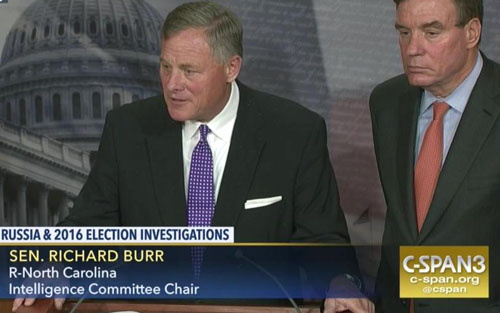by WorldTribune Staff, October 10, 2019
In what analysts say was a move to shift the spotlight off Ukraine’s meddling in the 2016 election on behalf of Hillary Clinton, the Senate Intelligence Committee on Oct. 8 released a so-called “bipartisan” report on Russia’s social media efforts during the 2016 election.
The irony is that the committee is chaired by an ostensible Republican.

The report concluded that the Russian social media campaign overwhelmingly boosted President Donald Trump.
Senate Intelligence Committee Chairman Richard Burr, North Carolina Republican, accompanied by Sen. Mark Warner, Virginia Democrat, held a press conference to discuss their report, which critics said mimicked the report by special counsel Robert Mueller.
The reports by the Senate panel and Mueller focused a great deal of attention on the so-called Russian Internet troll farm known as the Internet Research Agency (IRA). The IRA, the reports allege, was heavily engaged in spreading disinformation, most of which was to Clinton’s detriment.
Mueller indicted the IRA and other Russian nationals in February of 2018 on charges of violating laws “with U.S. elections and political processes.”
Just how effective and widespread the Russian trolls were, however, is widely disputed.
The IRA, “far from being a sophisticated propaganda campaign, was small, amateurish, and mostly unrelated to the 2016 election,” The Nation noted in a December 2018 report.
Reports from the University of Oxford’s Computational Propaganda Research Project and the firm New Knowledge indicated that it was difficult to square the real data with the “dramatic conclusions” that have been drawn by Mueller and, now, the Senate Intelligence Committee.
The Nation documented the real data:
• 2016 Election Content: The most glaring data point is how minimally Russian social-media activity pertained to the 2016 campaign. The New Knowledge report acknowledges that evaluating IRA content “purely based on whether it definitively swung the election is too narrow a focus,” as the “explicitly political content was a small percentage.” To be exact, just “11% of the total content” attributed to the IRA and 33 percent of user engagement with it “was related to the election.” The IRA’s posts “were minimally about the candidates,” with “roughly 6% of tweets, 18% of Instagram posts, and 7% of Facebook posts” having “mentioned Trump or Clinton by name.”
• Scale: The researchers claim that “the scale of [the Russian] operation was unprecedented,” but they base that conclusion on dubious figures. They repeat the widespread claim that Russian posts “reached 126 million people on Facebook,” which is in fact a spin on Facebook’s own guess. “Our best estimate,” Facebook’s Colin Stretch testified to Congress in October 2017, “is that approximately 126 million people may have been served one of these [IRA] stories at some time during the two year period” between 2015 and 2017. According to Stretch, posts generated by suspected Russian accounts showing up in Facebook’s News Feed amounted to “approximately 1 out of 23,000 pieces of content.”
• Spending: Also hurting the case that the Russians reached a large number of Americans is that they spent such a microscopic amount of money to do it. Oxford puts the IRA’s Facebook spending between 2015 and 2017 at just $73,711. As was previously known, about $46,000 was spent on Russian-linked Facebook ads before the 2016 election. That amounts to about 0.05 percent of the $81 million spent on Facebook ads by the Clinton and Trump campaigns combined. A recent disclosure by Google that Russian-linked accounts spent $4,700 on platforms in 2016 only underscores how minuscule that spending was. The researchers also claim that the IRA’s “manipulation of American political discourse had a budget that exceeded $25 million USD.” But that number is based on a widely repeated error that mistakes the IRA’s spending on US-related activities for its parent project’s overall global budget, including domestic social-media activity in Russia.
• Sophistication: Another reason to question the operation’s sophistication can be found by simply looking at its offerings. The IRA’s most shared pre-election Facebook post was a cartoon of a gun-wielding Yosemite Sam. Over on Instagram, the best-received image urged users to give it a “Like” if they believe in Jesus. The top IRA post on Facebook before the election to mention Hillary Clinton was a conspiratorial screed about voter fraud. It’s telling that those who are so certain Russian social-media posts affected the 2016 election never cite the posts that they think actually helped achieve that end. The actual content of those posts might explain why.
“So a few Facebook advertisements no one saw and a handful of Russian Twitter trolls no one paid attention to is now an assault on our democracy according to Burr and Warner,” the Gateway Pundit wrote.
Burr, who is not running for re-election when his term is up in 2022, angered the White House and many Trump supporters earlier this year when he issued a subpoena for Donald Trump Jr.
The panel’s report urges American tech firms to share more information with government agencies to thwart foreign disinformation efforts, and for lawmakers to consider legislation to better facilitate that sharing. It also calls on the executive branch to establish an interagency task force dedicated to monitoring and deterring foreign interference efforts online.
“Any solution has to balance America’s national security interests with our constitutionally-protected right to free speech,” Burr said. “Social media companies, federal agencies, law enforcement, and Congress must work together to address these challenges, and I am grateful for the cooperation our Committee has gotten from both the Intelligence Community and the tech industry.”
Intelligence Brief __________ Replace The Media
